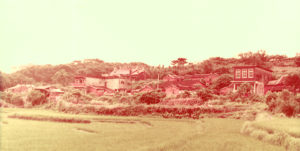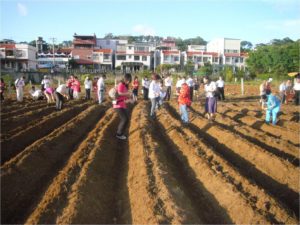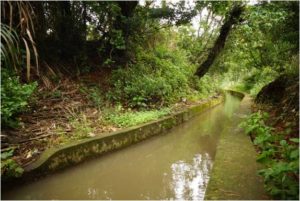The Water Carry Experience of Tamsui Tsai’s village
翻譯: 徐瑞儀


The Tamsui Tsai’s village is located on Provincial Highway 2, Danjin Road sec. 3, the right side of Kuiroushan Road. It has been 240 years since the Tsai’s migration from Tong’an District in Fujian Quanzhou Prefecture. When they first came to Taiwan, pirates and brigands were rampaging all over places; therefore, they gathered around Datun foothills to avoid their invasion.
The whole Tsai’s village lived by farming, the hills around were all cultivated by them, covering an area of over 20 acres, farming over 20 cows, it’s how they got the name of “Daniuchou’’. The early settlers irrigated the land by trenching and building canals and ponds, they also fought with the nearby families because of the distribution of water resources. After 70 years, in the 7th year of Xianfeng (A.D.1857), the nine biggest family (Tsia’s, Huang’s, Wang’s, Yang’s, Zhang’s, Lu’s, Lyu’s, Lin’s, Chen’s) co-developed “Sinjhuangzih Hongmao Canal principle’’ to set the rules and penalty for water sources. The pledge stipulated that ‘’ Zuntou river source still had bandits intercepting the water sources. If we catch someone stealing water from canals and rivers, the punishment is not only going to be playing Taiwanese opera all over Taiwan, but also have to pay for the banquet for the day.’’

Due to locating beside the Guirou stream on cordillera of Datun, where the groundwater sources are plentiful, the Tsai’s village decided to dig wells to carry water. Every family dug 1-2 wells, besides providing drinking water, it also has a partial function of paddy field irrigation. In the 82th year of the Republic Era, to cooperate with the provincial government’s ’’Farmhouse Demonstration Community’’ policy, an old farmhouse that was built over hundred years got razed to the ground. After years of rebuilding, they dug a well that is 280 feet deep and built a six-storied high water tower, then diverted water to the whole village by water pipe. In the same year, they organized a community management committee, set the water fee five dollars per cubic meter, and used the money to improve water quality, maintain pumping motors, and pay the electric bills. In the village where running water isn’t currently popular, this is the only way to manage water sources.
